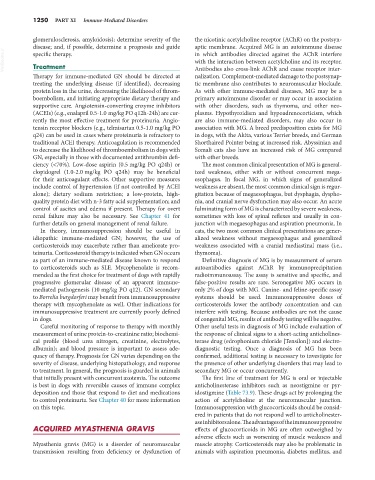Page 1278 - Small Animal Internal Medicine, 6th Edition
P. 1278
1250 PART XI Immune-Mediated Disorders
glomerulosclerosis, amyloidosis); determine severity of the the nicotinic acetylcholine receptor (AChR) on the postsyn-
disease; and, if possible, determine a prognosis and guide aptic membrane. Acquired MG is an autoimmune disease
VetBooks.ir specific therapy. in which antibodies directed against the AChR interfere
with the interaction between acetylcholine and its receptor.
Treatment
nalization. Complement-mediated damage to the postsynap-
Therapy for immune-mediated GN should be directed at Antibodies also cross-link AChR and cause receptor inter-
treating the underlying disease (if identified), decreasing tic membrane also contributes to neuromuscular blockade.
protein loss in the urine, decreasing the likelihood of throm- As with other immune-mediated diseases, MG may be a
boembolism, and initiating appropriate dietary therapy and primary autoimmune disorder or may occur in association
supportive care. Angiotensin-converting enzyme inhibitors with other disorders, such as thymoma, and other neo-
(ACEIs) (e.g., enalapril 0.5-1.0 mg/kg PO q12h-24h) are cur- plasms. Hypothyroidism and hypoadrenocorticism, which
rently the most effective treatment for proteinuria. Angio- are also immune-mediated disorders, may also occur in
tensin receptor blockers (e.g., telmisartan 0.5-1.0 mg/kg PO association with MG. A breed predisposition exists for MG
q24) can be used in cases where proteinuria is refractory to in dogs, with the Akita, various Terrier breeds, and German
traditional ACEI therapy. Anticoagulation is recommended Shorthaired Pointer being at increased risk. Abyssinian and
to decrease the likelihood of thromboembolism in dogs with Somali cats also have an increased risk of MG compared
GN, especially in those with documented antithrombin defi- with other breeds.
ciency (<70%). Low-dose aspirin (0.5 mg/kg PO q24h) or The most common clinical presentation of MG is general-
clopidogrel (1.0-2.0 mg/kg PO q24h) may be beneficial ized weakness, either with or without concurrent mega-
for their anticoagulant effects. Other supportive measures esophagus. In focal MG, in which signs of generalized
include control of hypertension (if not controlled by ACEI weakness are absent, the most common clinical sign is regur-
alone); dietary sodium restriction; a low-protein, high- gitation because of megaesophagus, but dysphagia, dyspho-
quality protein diet with n-3 fatty acid supplementation; and nia, and cranial nerve dysfunction may also occur. An acute
control of ascites and edema if present. Therapy for overt fulminating form of MG is characterized by severe weakness,
renal failure may also be necessary. See Chapter 41 for sometimes with loss of spinal reflexes and usually in con-
further details on general management of renal failure. junction with megaesophagus and aspiration pneumonia. In
In theory, immunosuppression should be useful in cats, the two most common clinical presentations are gener-
idiopathic immune-mediated GN; however, the use of alized weakness without megaesophagus and generalized
corticosteroids may exacerbate rather than ameliorate pro- weakness associated with a cranial mediastinal mass (i.e.,
teinuria. Corticosteroid therapy is indicated when GN occurs thymoma).
as part of an immune-mediated disease known to respond Definitive diagnosis of MG is by measurement of serum
to corticosteroids such as SLE. Mycophenolate is recom- autoantibodies against AChR by immunoprecipitation
mended as the first choice for treatment of dogs with rapidly radioimmunoassay. The assay is sensitive and specific, and
progressive glomerular disease of an apparent immune- false-positive results are rare. Seronegative MG occurs in
mediated pathogenesis (10 mg/kg PO q12). GN secondary only 2% of dogs with MG. Canine- and feline-specific assay
to Borrelia burgdorferi may benefit from immunosuppressive systems should be used. Immunosuppressive doses of
therapy with mycophenolate as well. Other indications for corticosteroids lower the antibody concentration and can
immunosuppressive treatment are currently poorly defined interfere with testing. Because antibodies are not the cause
in dogs. of congenital MG, results of antibody testing will be negative.
Careful monitoring of response to therapy with monthly Other useful tests in diagnosis of MG include evaluation of
measurement of urine protein-to-creatinine ratio; biochemi- the response of clinical signs to a short-acting anticholines-
cal profile (blood urea nitrogen, creatinine, electrolytes, terase drug (edrophonium chloride [Tensilon]) and electro-
albumin); and blood pressure is important to assess ade- diagnostic testing. Once a diagnosis of MG has been
quacy of therapy. Prognosis for GN varies depending on the confirmed, additional testing is necessary to investigate for
severity of disease, underlying histopathology, and response the presence of other underlying disorders that may lead to
to treatment. In general, the prognosis is guarded in animals secondary MG or occur concurrently.
that initially present with concurrent azotemia. The outcome The first line of treatment for MG is oral or injectable
is best in dogs with reversible causes of immune complex anticholinesterase inhibitors such as neostigmine or pyr-
deposition and those that respond to diet and medications idostigmine (Table 73.9). These drugs act by prolonging the
to control proteinuria. See Chapter 40 for more information action of acetylcholine at the neuromuscular junction.
on this topic. Immunosuppression with glucocorticoids should be consid-
ered in patients that do not respond well to anticholinester-
ase inhibitors alone. The advantages of the immunosuppressive
ACQUIRED MYASTHENIA GRAVIS effects of glucocorticoids in MG are often outweighed by
adverse effects such as worsening of muscle weakness and
Myasthenia gravis (MG) is a disorder of neuromuscular muscle atrophy. Corticosteroids may also be problematic in
transmission resulting from deficiency or dysfunction of animals with aspiration pneumonia, diabetes mellitus, and

